Crypt of the NecroDancer Preview
I must be mad.
I am not a dancer. Dancing is, and always has been, for people with greater natural agility and fewer inhibitions than me. Even in high school, when classes were roundly whipped onto the basketball courts and forced to dance to bloody Cotton bloody Eyed bloody Joe, you would have needed a theodolite and at least four points of triangulation to determine that I was, in fact, moving at all. And yet, my internet history doesn’t lie: dance pads. I think I need one. It’s insane, but I just have to try it. God knows how I’m going to convince Australia Post to sneak it into the house under cover of darkness, though.
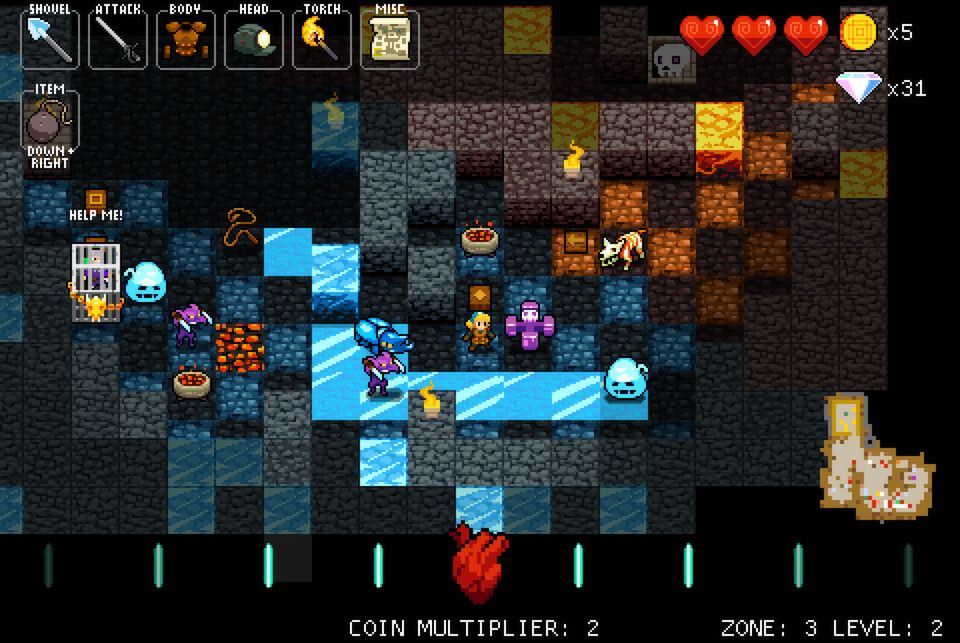
Crypt of the NecroDancer is the culprit behind this radical change, the latest in a long line of games that take a roguelike, drop it into a food processor with some unrelated genre, and press the ‘on’ button to a chorus of hideous graunching sounds. A rhythm-action roguelike on Early Access. It almost sounds like a weak joke, the kind I’d make while harping on about Risk of Rain and Eldritch and such, but it’s a surprisingly natural fit. And of all the roguelikes I’ve covered – I’m still determined to shoulder the term ‘rogue-lite’ out of existence, thank you – Crypt of the NecroDancer is probably the most traditional so far: you move in cardinal directions on a grid – hence the DDR pad – engage in turn-based combat (sort of), walk around some boxy rooms, pick up a ton of weapons and armour, and get to the stairs before time (or in this case, the song) runs out. It is, admittedly, a great deal more streamlined than traditional roguelikes – no inventory management, no elaborate damage system, no searching through the manual for ten minutes looking for the key-bind that lets you identify nearby traps – but it has a unique depth all of its own and more than enough potential combinations to keep me happy.
Of the two genres mashed together here, neither of them have exactly made a name for themselves via their storytelling, but Crypt of the NecroDancer does have – for lack of a better word – a premise, and it’s less contrived than you might imagine. It’s the opening cinematic that sets the scene: Cadence, our protagonist (music puns, ahoy) is out digging in a graveyard for slightly cloudy but presumably good purposes – unless the big twist is that she’s a Necrodancer, and she just needed some fresh corpses in a hurry, I don’t know – when the roof of the titular crypt caves in underneath her, causing a near-fatal fall. She survives thanks to the sudden appearance, stage left, of the real Necrodancer, who looks for all the world like an eighties fantasy cartoon villain – complete with billowing cloak – but nevertheless fulfils his duty as a good citizen by restarting her heart. Alright, so it only beats in time with nearby music, but that’s a small price to pay, right?
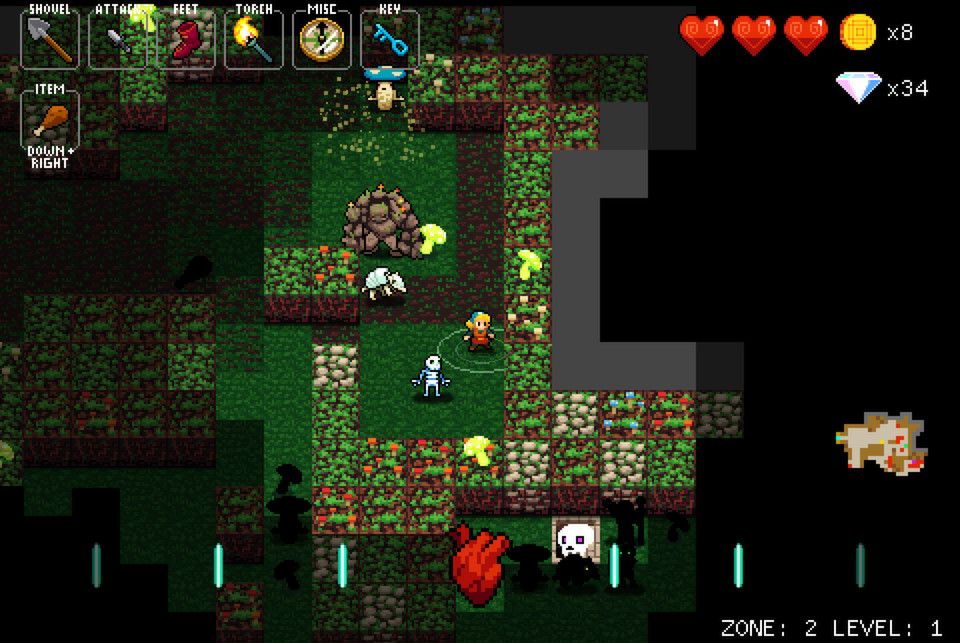
In a roundabout sort of way, the fusion of rhythm-action and roguelike makes perfect sense. Combat in traditional roguelikes has always been something of a turn-based dance; carefully stepping here and there, into recently-vacated space and away from encroaching foes, to maximise damage and dodge enemy attacks. Necrodancer – I’m just going to call it Necrodancer, because stylised capitalisation is the work of language heretics – simply speeds things up a little bit. Instead of having all the time in the world to ponder your next move, you and everything else in the dungeon are compelled to move to the inexorable beat of the song. Suddenly, through this one small change, the game becomes an intense exercise in constant planning, thinking ahead, and split-second decision making. Situations that you could have once tackled over the course of a few minutes now have to be solved in seconds, all while moving to that wretched, overpowering beat. Within moments of entering a room, you need a plan. Step left, step up, lunge at the skeleton, dig out a wall to skip a beat, cut the slime that just moved into range, dodge the fireball, step around the trap tile… whoops, looks like you didn’t take that wind wizard into account, you dolt. Now you’ve been pulled off course, you’ve missed a beat, dropped your coin multiplier, and you’re about to be attacked from three different directions. You have about twenty-five milliseconds before the next beat hits and those attacks land. It’s exhilarating, being put on the spot like this, and there’s nothing more satisfying than fighting your way out of a chaotic melee without taking a scratch.
That’s the truly beautiful thing about Necrodancer’s combat: it’s almost always possible to handle a fight in such a way that you completely evade damage. Every enemy moves according to a certain pattern, some simpler than others, and the key to survival is to dance around them; to step nimbly out of reach on the beat before a scything attack, to dart in and strike while they’re recoiling, to move warily around them until the perfect opportunity. You’ll have to learn to dance like this too, at least if you plan to beat the game at some point, because Cadence is as fragile as a sheet of plate-glass being carried across a busy road, which I suppose is inevitable when you go out on an adventure in your gardening gear. In the very first level of the very first zone, there are certain enemies that can kill you in a single hit, and it only gets harder from there. Initially it feels ruthlessly unfair, punishing you needlessly for even the slightest slip-up, but as you learn enemy patterns and weapon behaviours, it smooths out into a more reasonable – but still, of course, exceptionally challenging – experience. It’s a brand of difficulty that will seem very familiar to any seasoned Spelunky player, in the sense that death is avoidable but nevertheless entirely expected, and first and foremost your fault. Oh, it may be down to a matter of ignorance sometimes, but the learning experience is part of the fun.
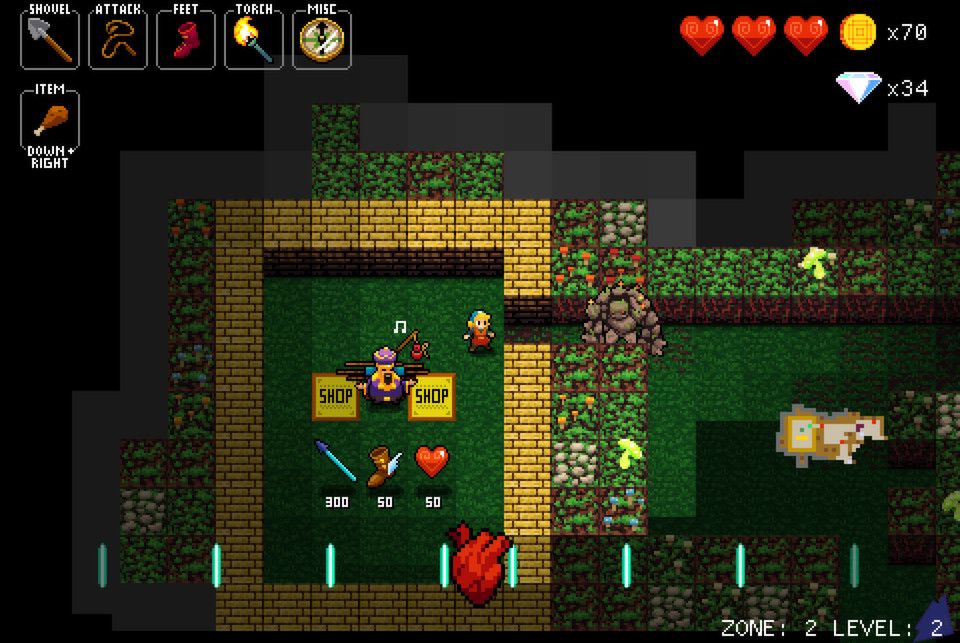
Right, I think I’ve soaped the game’s armpits for long enough: let’s talk about rubbish. Necrodancer is Early Access, after all; a platform that has acquired something of a reputation for being a mixed bag full of rusty gardening equipment and awful me-too survival sandboxes. Though Necrodancer might not be nearly as bad as some of the examples that intrepid people have dredged up, it is nevertheless undeniably incomplete. Of the four zones planned only three are actually available, with the fourth and final zone lying tantalisingly locked-off on the hub screen. Since each zone has a unique set of enemies this essentially means that an entire quarter of the game’s content is still in the works, to say nothing of the conspicuous absence of a final boss. I’d get more up in arms about it but I can’t, partially because the stuff that’s already in the game has been polished to a 16-bit shine, but primarily because I estimate that I’m not actually going to successfully beat zone three until about late 2015. It’s hard, okay?
What I definitely can get up in arms about is the game’s upgrade system. Remember that learning experience I was gushing about so insufferably? Well, it’s tainted by the totally unnecessary process of unlocking all your equipment first. While exploring the game’s dungeons you occasionally happen across diamonds – lying on the ground, embedded in walls, and carelessly left in vending machine coin-return slots – which will, once you return to the hub, allow you to buy new armour, weapons, rings, spells, and other miscellaneous bits of equipment, which will in turn proceed to be added to the pool of items that randomly appear in the dungeon. More insultingly, however, you can buy straight-up upgrades to Cadence that raise your base coin multiplier, increase your starting health, and drop more chests in the dungeon. This was a bad idea in Rogue Legacy and neither time nor circumstances have ripened it. The fundamental idea of a roguelike is that you, as a player, get better and better through constant practice until you are able to overcome the fickle whims of the random number generator, but permanent upgrades make a mockery of that. Why bother trying to beat this zone when you can just grind away until you’ve nearly tripled your health? I have similar gripes about unlocking equipment. I suppose the idea here was that you would be able to learn how your small starting pool of weapons and items works before gradually adding new entries to it, but while you do unlock equipment at a fairly swift pace – swift enough, in fact, to make the system’s supposed purpose irrelevant – it’s not so fast that it doesn’t end up feeling like a serious grind by the end. There’s just something ignoble about a roguelike that grows easier with time; it puts a black stain of doubt on any accomplishments one might otherwise be proud of. Did I really grow more skilful to the point where I could consistently take on zone two? Or was it just the six extra hit-points lowering the bar enough for me to daintily step over it?
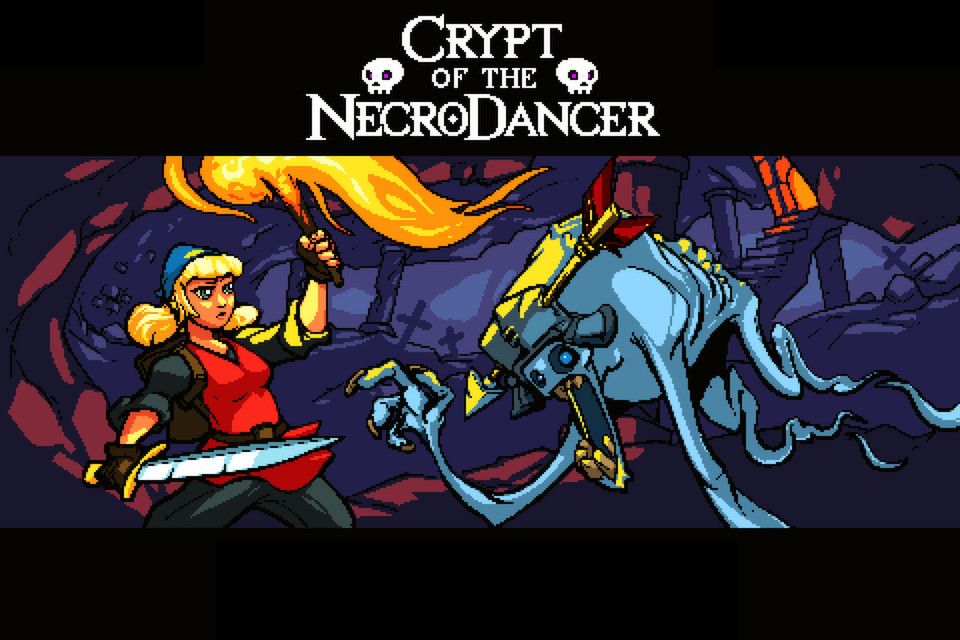
The great irony of all this is that even now, I’m still pretty hazy on a lot of items lying around in the dungeon. The cat o’ nine tails, a sort of lunging weapon that hits nearby squares according to some mysterious arcane rule, is about as useful in my hands as a length of rotten driftwood, and the only reason I know the difference between the different shovels is because I went and looked them up. This ambiguousness extends to some of the enemies, too: for all my talk of patterns and elegant dances, I still for the life of me can’t work out what kind of mad clockwork dictates the bats’ movements. Seems like no matter what kind of roguelike I’m playing, bats are always the wild-card. You can, in fact, pay diamonds – more bloody diamonds, again! – to train against monsters, bosses and mini-bosses in a safe environment, which I thought was a nice touch – though it still doesn’t help with the bats – but there’s no such option to practice with equipment. I mean really, Necrodancer, why not? You might as well, since you’re so hell-bent on finding things to spend my diamonds on. This really is one of those games where you have to consult a wiki if you ever plan to understand its exact mechanisms, which I’ve always felt is kind of a cop-out over, say, clear and intuitive design that makes itself apparent after a few encounters, but a roguelike with an enduring mystique is a roguelike that keeps me fascinated, so I think I can find it in me to forgive that.
Ultimately, Necrodancer wins me back with its hardcore mode, which throws away all those asinine upgrades, unlocks the full item pool, and puts up a global high-score board for one long push through all three zones in a row. I’d like to call it the ‘real’ mode and open the taps wide on my most sickening reserves of roguelike elitism, but that would be doing a disservice to the game’s other modes: a Spelunky-esque daily challenge, a dedicated dance pad mode that makes the game slightly easier – you can still play it with a keyboard though, if you’re a scumbag – and surprisingly, local two-player co-op. Sadly I couldn’t find anybody to come over to my house and crowd around a keyboard with me so that we could play some game that they’ve never heard of, but it seems functional. Only one person needs to actually move on the beat in order to keep the coin multiplier going, so you might even be able to play it for more than five minutes without thinking murderous thoughts about your partner. There’s also a limited selection of different characters (most of them still locked away by glaring ‘work in progress’ signs) who alter the gameplay in subtle ways and have their own associated high-score boards: Aria, who has one hitpoint and dies if she misses a beat, and is therefore perfect if you’ve recently had some cybernetic implants installed; Bolt, who has to move twice per beat (geddit, ’cause he has to bolt everywhere); and the Bard, who can move whenever he likes, making him the ideal choice if you want to subtract the single best thing about the game from the game for some mind-skewering reason.
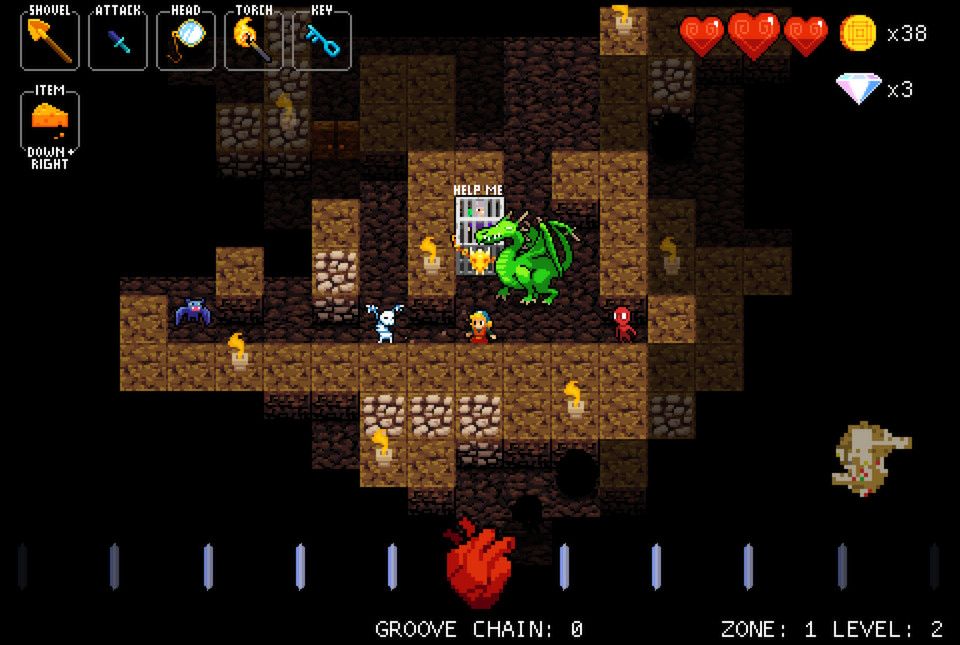
Alright, so ‘single best thing’ is a fairly close-run accolade. Second place just barely goes to the soundtrack, which is – without hyperbole – Danny Baranowsky’s single greatest work to date. Yes, better than Super Meat Boy. I don’t know a thing about electronic music, but this soundtrack makes me want to go learn about it just so I can elucidate how good it is. You know how chiptune fanatics go crazy for the VRC6 chip because it made the Famicom actually bearable to listen to? Well, just imagine that this soundtrack was written for some kind of hypothetical Super Nintendo chip that only ever existed in the imagination of a post-fever-dream Konami employee. It has synths within synths, hitting its absolute peak with the musically-themed boss fights: a game of speed chess against a blues bassist, a zombie conga line (presided over by a pedantic gorilla who enforces strict conga etiquette) and a heavy metal lich with a microphone on his scythe and a speaker embedded in his chest. That last one had better be on an album cover somewhere. You can also replace the music for the various levels with your own MP3s, but unless your chosen track has a strong, steady beat, the game is liable to just throw its arms up in the air in overwhelmed confusion. If it doesn’t, then you certainly will.
I find it strange to think of Necrodancer in terms of Early Access. In spite of its glaring content deficit – not even having a final boss, I mean honestly guys – it feels like a complete, free-standing experience, well-worth its asking price. Everything that’s there gives an intangible sense of having been polished, tested, tweaked, and polished again for good measure. Many Early Access purchases feel as if you’re buying a game that’s only seventy-five percent complete – or if you’re unlucky, considerably less than that – but Crypt of the NecroDancer just feels like seventy-five percent of a game, sliced cleanly off the final product. I wouldn’t blame you in the slightest if you wanted to wait until that final product was available, but what you get right now is an idea that works better than it has any right to, well-presented and challenging enough to make the most of its meagre content. Still, since I’m technically an alpha tester I ought to provide some constructive feedback, so here it is: make the bats more predictable, toss away the upgrade system, and give Danny Baranowsky a raise, Brace Yourself Games. Oh, and please mail an appropriately disguised dance pad to XXXXXXXXXX, XXXXXXXX, XXXXXX [Ed. Note: Address redacted to avoid awkward mail deliveries]. Just for testing purposes, of course.
